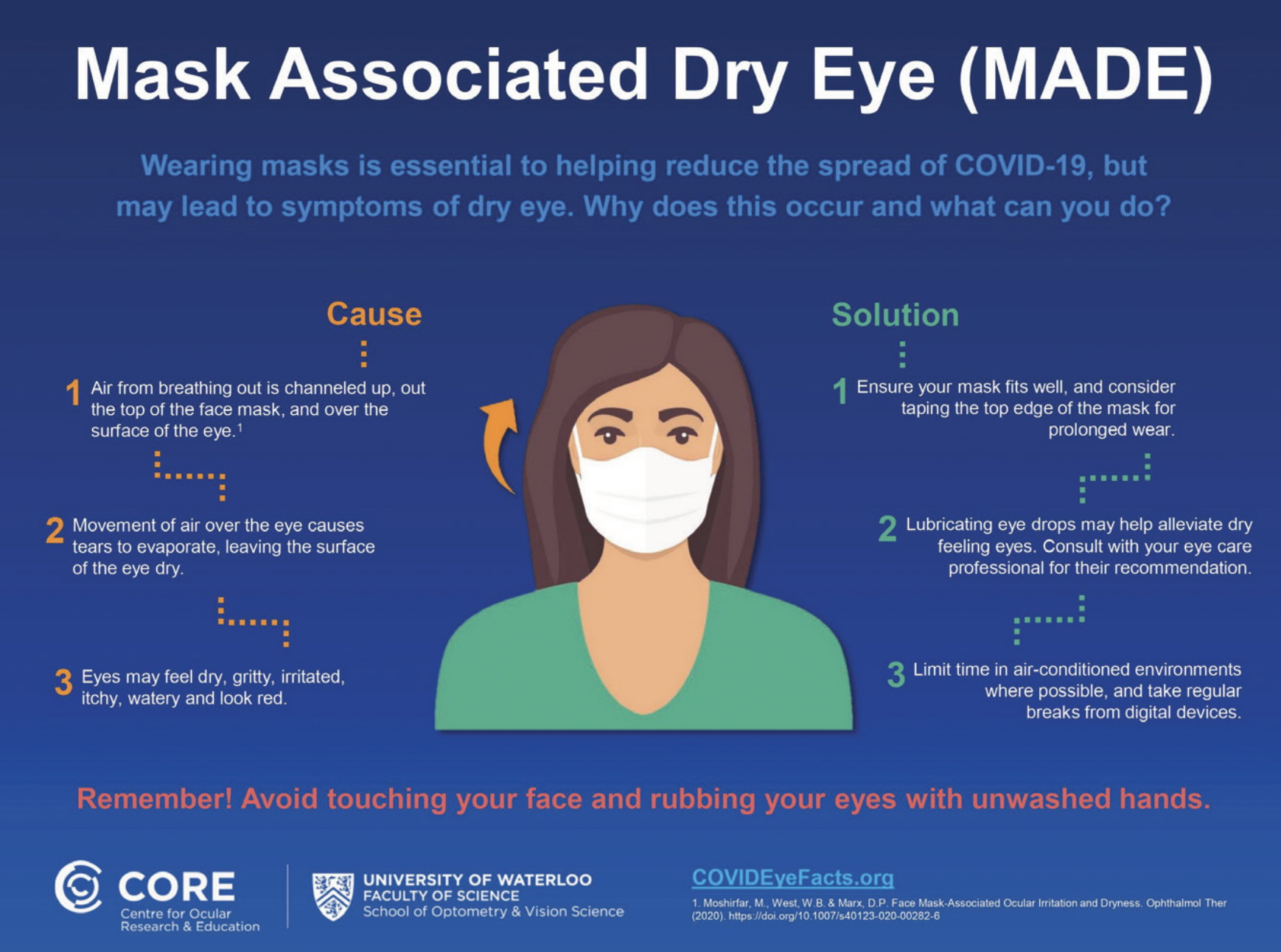Wearing a face mask is the new norm caused by the pandemic. People are wearing a face mask to prevent infection of the Covid 19 virus while working, conducting physical school activities or during leisure activities. Various problems have arisen from long hours of face mask wear.

How it happens?
Mask associated dry eyes is due to the redirection of the forward spread of air from the mouth and nose towards the ocular surface which increases the rate of tear film evaporation, resulting in increased tear osmolarity, dehydration and loss of cells in the cornea and conjunctiva, which results in ocular irritation and inflammation. Tear film stability is further degraded and the cycle of dry eyes induced changes go on. Inappropriate air flow is reported to cause exposure keratopathy, dry eyes syndrome and increased risk of post-operative infection which are believed to be caused by poor-fitting of face masks that expose the vulnerable ocular surface.
Who will be most affected?
The risk of dry eyes syndrome is proved to be higher in elderlies, females and Asians. However, masks associated with dry eyes are associated with extensive use of masks like a medical practitioner and patients, history of dry eyes syndrome, history of recent ophthalmic surgery or ocular surface inflammation. Poor-fitting of the face mask may be another risk factor.
For the post-operative patient, face mask usage should be minimised and a 24 hours usage of postoperative dressing to promote healing in the early postoperative period is recommended. Lubricant eye gel should be used since the early post-operative period to retain moisture of the ocular surface and to reduce symptoms of dry eyes. Take a break from mask-wearing by removing the face mask and applying lubricant eye drops every few hours as advised by the eye care practitioners. Emollient eye drops replenish the lipid layer of tear film to reduce evaporation of tear film from the ocular surface. Emollients like mineral oil and light mineral oil, form a protective film to trap moisture.
Poor Blinking
Poor blinking causes dryness in the eyes so practising blinking exercise on the other hand train the eye muscles to improve blinking and the spreading of the regular tear film over the ocular surface.
The exercise starts with closing both eyes normally without forcing them to close, pausing for 2 seconds with both eyes closed, then opening the eyes. To check if you are blinking normally, gently place your finger over the bone around your eyes and feel the movement of muscles around the eyes. The movement should be very little. Next, it is followed by closing both eyes normally, pausing with both eyes closed for 2 seconds, 2 seconds of aggressive squeezing of eyelids together as if you want to crack something in between, then opening the eyes. The two steps are repeated every 20 minutes for 20 times per day to improve the muscle memory of proper blinking.
App that aids blinking training
Donald Korb Blinking Training is free iPhone App that uses audio signaling to remind you of the exercise every day. Any phone alarm can be a useful alternative. Extensive periods of sustained visual activity, especially near work that has high demand in students and working adults like reading, computer or smartphone usage cause decreased blinking rate naturally. It should be beneficial to place a copy of the blinking exercise next to the desktop, on the wall or on the working desk to remind yourself of your routine to improve blinking.
Mask-associated dry eyes is just another type of dry eye that has been existed in patients with an extensive period of face mask usage. For instance, it is often found with exposure to keratopathy in patients in the Intensive Care Unit. There is an increase in the reported cases currently due to increased usage of face masks in response to the pandemic. If you feel any irritation or dryness in the eyes, feel free to visit eye care professionals for more information.
